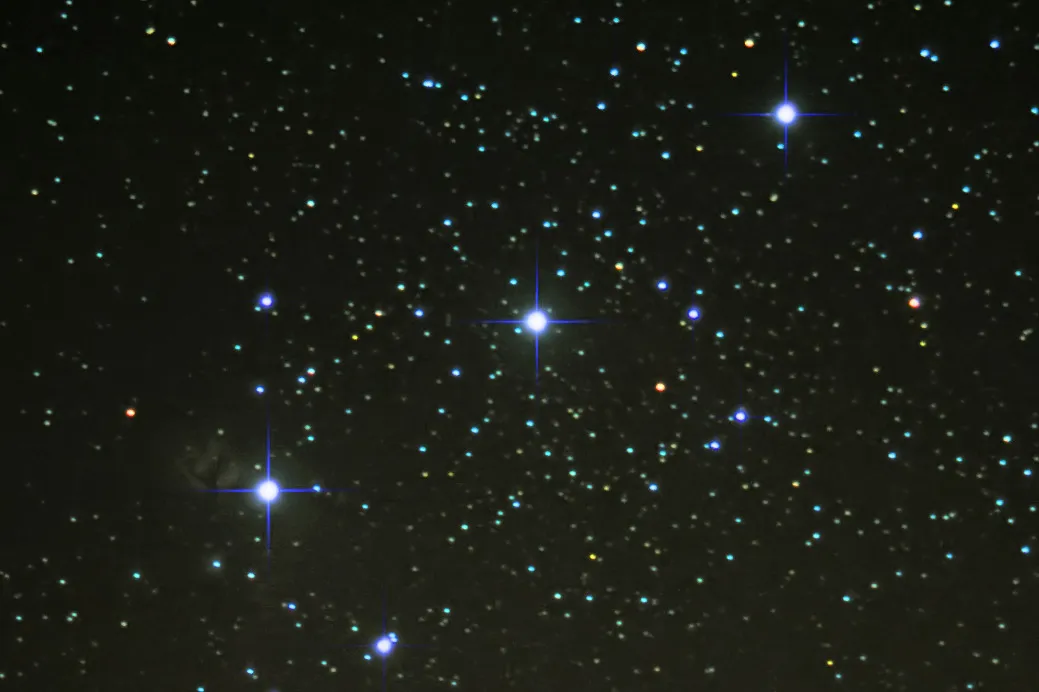Winter is the best time of year for newcomers to astronomy. It gets darker earlier, the atmosphere is clearer and some of the best constellations are visible in the night sky.
Within these constellations you can see deep-sky objects such as galaxies, star clusters and nebulae.

Orion is one such constellation.
It’s a great starting point for beginners because it is instantly recognisable in the winter sky and contains wonderful stars and deep-sky objects that demand closer inspection.
Here we’ll explore some of Orion’s astronomical treasures and how you can view them.
10 targets to see in Orion
Orion's Belt

Orion is easy to spot because of the three stars in an almost straight line that run through its middle. These are (left to right) Alnitak, Alnilam and Mintaka, and they form Orion’s Belt, an asterism (pattern of stars) within the larger constellation.
Alnitak is a triple star system, Alnilam is 375,000 times brighter than the Sun and Mintaka is a binary star system (two stars orbiting each other).
Orion’s Belt forms part of a larger open cluster known as Collinder 70.
Betelgeuse and Rigel

At opposite corners of the figure of Orion are its two brightest stars. Betelgeuse and Rigel are winter night-sky celebrities.
Betelgeuse is a red supergiant with an orange hue that is greatly enhanced through binoculars and telescopes.
A thousand times bigger than our own Sun, if you placed Betelgeuse in the centre of our Solar System it would swallow up Jupiter.
In the far future, Betelgeuse will explode as a supernova, and will be so bright it will cast shadows on the ground.
In contrast, icy-blue Rigel is a blue supergiant star 70,000 times more luminous than our own Sun. At a magnitude of +0.12, it is the seventh-brightest star in the night sky.
Bellatrix

Harry Potter fans may recognise the name Bellatrix, but might not know it's the third-brightest star in Orion.
Bellatrix lies in the top right corner, 5° to the west of Betelgeuse.Its name means ‘female warrior’ in Latin.
This blue giant star, almost six times the Sun’s diameter, is just 25 million years old. Shining at mag. +1.6, it is the 25th-brightest star in the sky.
Saiph

The faintest of the four corner stars of Orion, blue-white Saiph – from the Arabic word for ‘sword’ – is another supergiant. Although it’s 56,000 times more luminous than our own Sun, its distance of around 650 lightyears reduces it to mag. +2 in our sky.
The Orion Nebula

The Orion Nebula, M42, lies in the centre of Orion’s Sword, a short vertical line of three fainter stars that hangs from Orion’s Belt.
It looks like the middle ‘star’ of the sword to the naked eye, a little fuzzier than the stars above and below it.
Composed of dust and gas and located 1,344 lightyears away, it can be seen with the naked eye and is a perfect pitstop for beginners.
A pair of 10x50 binoculars will enhance the nebula, while a small telescope will bring out dark and light patches.
Trapezium Cluster

Embedded in the heart of the Orion Nebula, the Trapezium Cluster is a tight open cluster of stars born from the surrounding dust and gas.
The cluster appears as a single starry point through binoculars, but its four brightest stars are revealed through medium-aperture telescopes.
Through a large telescope, it is a stunning sight, illuminating the gas and dust behind and around it.
The Horsehead Nebula

The Horsehead Nebula is a ‘dark nebula’ – a cloud of dust silhouetted against brighter gas behind it.
It’s just beneath Alnitak, the star shining on the eastern end of Orion’s Belt.
If you want to see it you’ll need a dark sky, a high-power eyepiece in your telescope and a Moon-free night.
You’ll see the nebula as a dark notch on the lighter background. Under perfect conditions, it looks like a knight chess piece.
The Flame Nebula

Somewhat overshadowed by its bigger and more famous neighbours, the Orion and Horsehead Nebulae, the Flame Nebula is a cloud of dust and gas illuminated by Belt star Alnitak.
Visible as a roughly cone-shaped smudge through small telescopes, larger instruments show it cut down the middle by a dark dust lane.
The nebula is a great photographic target: even short unguided exposures with a DSLR camera on a tripod will record it well.
Sigma Orionis

At the eastern end of Orion’s Belt, just south of Alnitak, this fourth-magnitude multiple star is the brightest member of a young open star cluster sprinkled across the same telescopic field of view as the Horsehead Nebula.
The cluster has several dozen members bright enough to be seen through a telescope.
Sigma itself is a system of five stars and even a small telescope will resolve its brightest components, making it a popular target for backyard observers.
This guide originally appeared in the December 2022 issue of BBC Sky at Night Magazine

